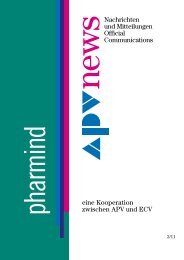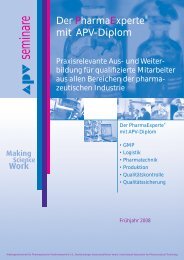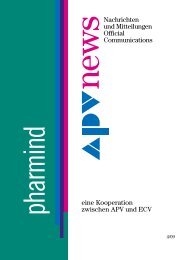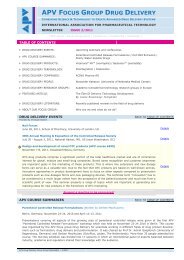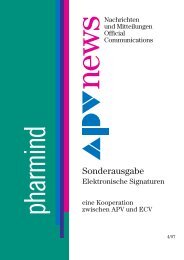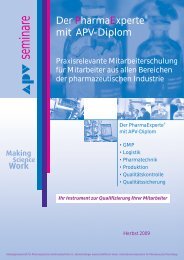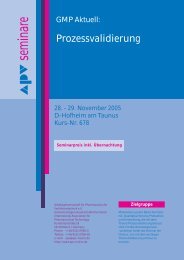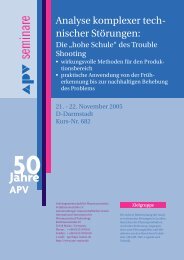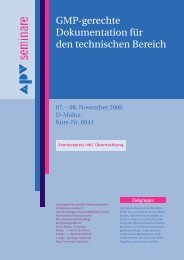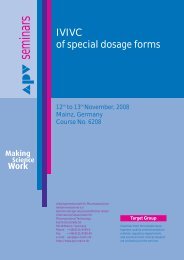APV FOCUS GROUP DRUG DELIVERY
APV FOCUS GROUP DRUG DELIVERY
APV FOCUS GROUP DRUG DELIVERY
You also want an ePaper? Increase the reach of your titles
YUMPU automatically turns print PDFs into web optimized ePapers that Google loves.
TABLE OF CONTENTS<br />
<strong>APV</strong> <strong>FOCUS</strong> <strong>GROUP</strong> <strong>DRUG</strong> <strong>DELIVERY</strong><br />
COMBINING SCIENCE & TECHNOLOGY TO CREATE ADVANCED <strong>DRUG</strong> <strong>DELIVERY</strong> SYSTEMS<br />
INTERNATIONAL ASSOCIATION FOR PHARMACEUTICAL TECHNOLOGY<br />
NEWSLETTER ISSUE 3/2010<br />
| <strong>APV</strong> Home | Focus Group Home | Contact us | Unsubscribe | Disclaimer |<br />
◊ <strong>DRUG</strong> <strong>DELIVERY</strong> EVENTS: Upcoming seminars and conferences<br />
◊ <strong>APV</strong> COURSE SUMMARY: Current Trends in Paediatric Drug Delivery<br />
◊ <strong>DRUG</strong> <strong>DELIVERY</strong> PRODUCTS: TOBI ® Podhaler ® / PecFent ® Nasal Spray<br />
◊ <strong>DRUG</strong> <strong>DELIVERY</strong> COMPANIES: MEDINCELL S.A. (Montpellier, France / San Diego, California, USA)<br />
◊ <strong>DRUG</strong> <strong>DELIVERY</strong> TERMINOLOGY: Chronobiology / Chronopharmaceutics<br />
◊ <strong>DRUG</strong> <strong>DELIVERY</strong> PEOPLE: William N. Charman, Monash University, Melbourne, Australia<br />
◊ FEATURED ARTICLE: Drugs in the Lungs: A New Academic-Industrial Consortium Dedicated to the<br />
Collaborative Advancement in Inhaled Product Development<br />
By Lea Ann Dailey and Ben Forbes<br />
◊ <strong>DRUG</strong> <strong>DELIVERY</strong> LITERATURE: Recently published reviews in the field of drug delivery<br />
◊ ABOUT OUR <strong>FOCUS</strong> <strong>GROUP</strong>: Who are we and what do we do?<br />
<strong>DRUG</strong> <strong>DELIVERY</strong> EVENTS BACK TO TABLE OF CONTENTS<br />
Provided by Christoph Blümer<br />
◊<br />
◊<br />
Poorly Soluble Drugs (<strong>APV</strong> Course No. 6336 - in cooperation with BASF)<br />
th th<br />
28 -29 Oct. 2010, Ludwigshafen, Germany<br />
Chairs: Dr. Carsten Timpe, Novartis Pharma AG, Basel, Switzerland<br />
Dr. Oskar Kalb, F. Hoffmann-La Roche AG, Basel, Switzerland<br />
This course is designed to convey a solid understanding of patents and their role in the pharmaceutical<br />
industry, and to provide the attendee with the professional skills required to collaborate successfully with<br />
patent experts. Especially recommended for scientists and managers who are involved in evaluating inventions,<br />
preparing patent applications, supporting freedom-to-operate analyses, or who are members of<br />
due diligence teams.<br />
Transdermal Drug Delivery Systems - The Essentials of Industrial Development<br />
(<strong>APV</strong> Course No. 6315)<br />
28 th -29 th Oct. 2010, Miesbach, Germany<br />
Chairs: Dr. Stefan Bracht, Bayer Schering Pharma AG, Berlin, Germany<br />
Prof. Dr. Johannes Bartholomaeus, Pharmakreativ Consulting, Aachen, Germany<br />
The objective of this seminar is to provide participants from industry, regulatory bodies and academia with<br />
an insider perspective of the challenges involved in the industrial development of transdermal drug delivery<br />
systems. Typical issues and specific problems will be addressed in order to facilitate a deeper understanding<br />
of this dosage form and the related manufacturing processes. The course will also specifically<br />
address the needs of those participants who are in charge of managing, regulating or in-licensing development<br />
projects in this field.<br />
FIP Pharmaceutical Sciences 2010 World Congress<br />
th th<br />
14 -18 Nov. 2010, New Orleans, Louisiana, US<br />
Drug Delivery to the Lungs - DDL21<br />
th th<br />
8 -10 Dec. 2010, Edinburgh, Scotland, UK<br />
World Drug Delivery and Formulation 2011<br />
th th<br />
17 -18 Jan. 2011, Berlin, Germany<br />
Details<br />
Details<br />
Details<br />
Details<br />
Details<br />
<strong>APV</strong> Drug Delivery Focus Group Newsletter – 3/2010 Page 1 of 10
◊<br />
Parenteral Controlled Release Formulations (<strong>APV</strong> Course No. 6342)<br />
rd th<br />
23 -24 Nov. 2010, Berlin, Germany<br />
Chairs: Gerben Moolhuizen MBA, OctoPlus N.V., Leiden, The Netherlands<br />
Prof Dr. Achim Göpferich, University of Regensburg, Germany<br />
Parenteral controlled release formulations were originally developed to deliver peptide drugs with short in<br />
vivo half lives or in rare cases low molecular weight compounds over extended periods of time. Given the<br />
plethora of biologics being currently developed there are new challenges ahead that are not necessarily<br />
met by existing technology and excipients. The seminar will cover the developments in the field in recent<br />
years and will provide an outlook on current and future developments. There will be a particular emphasis<br />
on the challenge of formulating biologics in these systems and the formulation development, manufacturing<br />
and regulatory issues involved in bringing parenteral controlled release formulations to the market.<br />
Suggest a meeting to be announced!<br />
Details<br />
<strong>APV</strong> COURSE SUMMARY BACK TO TABLE OF CONTENTS<br />
Provided by Dr. Louise Rosenmayr-Templeton<br />
Current Trends in Paediatric Drug Delivery<br />
th th<br />
Berlin, 24 -25 November 2009<br />
A broad overview of current trends in paediatric drug delivery was given at the <strong>APV</strong> course No. 6268 on November 24-<br />
25, 2009 in Berlin by top experts in the area. The course was organised by the <strong>APV</strong> Drug Delivery Focus Group and was<br />
chaired by Oskar Kalb from Roche and Carsten Timpe from Novartis with international participation from industry, universities<br />
and health authorities.<br />
Paediatric legislation in the US and in Europe has been introduced during this decade with the objectives of improving<br />
children’s health by increasing the availability of authorised medicinal products and improving the information about<br />
these drugs when administered to children. Launching paediatric drugs also gives the pharmaceutical industry the economically<br />
interesting opportunity to extend the patent expiry dates of their originator drug products. However, the development<br />
of paediatric medicines is not always an easy task, and the pharmaceutical industry, paediatricians and<br />
health authorities now need to work much more closely together than in the past.<br />
Children are not just small adolescents. They differ in age and physiological development, (metabolism, body weight,<br />
organ masses, distribution of body water and fat, liver and renal functions etc.) and require tailor-made drug delivery<br />
concepts. In these respects there is a clear differentiation between newborn infants (0 - 28 days), infants/toddlers (1<br />
month – 2 years), preschool children (2 – 5 years), school children (6 - 11 years) and adolescent children (12 - 16/18<br />
years). These requirements have multiple implications for the design of paediatric studies in the clinic, the development<br />
of age specific dosage forms, the degree of care required to ensure young patient population compliance (taste, odour,<br />
size of dosage forms, children friendly parenteral devices etc.) and also for the strict limitation of critical toxic byproducts,<br />
solvents etc. in the drug product. Specific paediatric drug delivery devices are now under development to<br />
facilitate delivering the right doses in an improved patient centric way (e.g. special spoons, small mini-tablets, drinking<br />
straws etc.).<br />
The course covered recent specific paediatric regulatory requirements in the EU (e.g. experiences with paediatric investigation<br />
plans, called “PIPS” and in the US) presented by Dr. Karin Heidenreich (Novartis, Switzerland) and provided<br />
useful information on:<br />
• Patient population requirements and market (Prof. Joachim Boos, Münster, Germany)<br />
• Oral paediatric dosage forms from the perspective of a drug delivery company (Dr. Derek Moe, Cima Labs, USA)<br />
• Formulation development challenges and perspectives from a big pharma company standpoint (Dr. Fabrice<br />
Mouveaux, Sanofi Aventis, Paris, France)<br />
• Age specific needs and solutions regarding drug delivery for neonates, infants and children (Dr. Catherine Tuleu,<br />
School of Pharmacy, London, UK)<br />
• Children-friendly extemporaneous dosage forms (Dr. John M. Hempenstall, GlaxoSmithKline, UK)<br />
• Acceptability of pharmaceutical excipients for children`s medications, standard and novel dosage forms like lollipops,<br />
soft-chews etc. (Dr. Gesine Winzenburg, Novartis, Switzerland)<br />
• Taste assessment via modern electronic tongue systems and taste optimization (Prof. Jörg Breitkreutz, University<br />
of Düsseldorf, Germany),<br />
• Paediatric pulmonary aspects (Dr. Lea Ann Dailey, King`s College, London, UK)<br />
• Modern children friendly dosing devises, e.g. sipping technology (Franz X. Schwarz, Sandoz, Austria)<br />
<strong>APV</strong> Drug Delivery Focus Group Newsletter – 3/2010 Page 2 of 10
<strong>DRUG</strong> <strong>DELIVERY</strong> PRODUCTS BACK TO TABLE OF CONTENTS<br />
Provided by Dr. Louise Rosenmayr-Templeton<br />
®<br />
TOBI Podhaler ® (Novartis Europharm Ltd.)<br />
On 23 rd September 2010 the European Medicines Agency’s Committee for Medicinal Products for Human Use (CHMP)<br />
issued a positive opinion on TOBI ® Podhaler, 28mg, inhalation powder, hard capsules from Novartis Europharm Ltd. This<br />
product is indicated for the treatment of cystic fibrosis patients aged 6 years and older with chronic pulmonary infection<br />
due to Pseudomonas aeruginosa. The product contains tobramycin, an aminoglycoside antibiotic, which was first<br />
approved for this indication in 1997 in the form of a solution for nebulization. The new TOBI ® Podhaler was granted<br />
orphan medicinal product status in the EU on 17 March 2003.<br />
Treatment of pulmonary Pseudomonas aeruginosa infections with tobramycin in cystic fibrous patients involves repeated<br />
cycles of 28-day twice daily dosing followed by a 28-day non-treatment period. With the existing formulation each<br />
administration takes 15 to 20 minutes exclusive of nebulizer assembly, disassembly and cleaning and, hence, patient<br />
compliance can be low with some patient failing to clean their nebulizer thoroughly.<br />
With the TOBI ® Podhaler the tobramycin is administered as a dry powder containing particles produced using<br />
PulmoSphere ® Technology. This technology produces low density, porous particles of drug by spray-drying in the correct<br />
size range for deep penetration into the lung. The technology was originally developed by Nektar Therapeutics who sold<br />
its pulmonary business to Novartis in 2008. Clinical studies have shown that the dry powder formulation is just as<br />
efficacious as the nebulized one and has a comparable safety profile. However, the real advantage of the new formulation<br />
lies in its convenient use.<br />
The Podhaler is portable, disposable, requires no power source and enables the drug to be administered in 5 to 6 minutes,<br />
resulting in significantly higher patient satisfaction. In addition, the tobramycin powder, unlike the solution, does<br />
not require refrigeration.<br />
References and Further Information:<br />
• CHMP Summary of Opinion on TOBI Podhaler on European Medicines Agency website<br />
• Press release on Novartis website:<br />
http://www.novartis.com/newsroom/media-releases/en/2010/1446760.shtml<br />
• Full Prescribing Information for TOBI Inhalation Solution:<br />
http://www.pharma.us.novartis.com/product/pi/pdf/tobi.pdf<br />
• Press release on Novartis website:<br />
http://www.novartis.com/newsroom/media-releases/en/2008/1261361.shtml<br />
®<br />
PecFent Nasal Spray (Archimedes Pharma Ltd.)<br />
September started well for Archimedes Pharma Ltd, Reading, UK when on the 1 st of the month the European Commission<br />
granted marketing authorisation for its fentanyl nasal spray, PecFent ® . This follows a recommendation for approval from<br />
the CHMP in June. The nasal spray is available in two strengths: 100 μg/100 μl and 400 μg/100 μl and is indicated for<br />
the management of breakthrough pain in adults who are already receiving maintenance opioid therapy for chronic cancer<br />
pain.<br />
The drug is formulated using the company’s pectin-based PecSys technology. In two randomised, double-blind Phase<br />
®<br />
III clinical trials, use of PecFent was shown to result in clinically relevant relief of breakthrough pain 10 minutes after<br />
spray administration. A paper on one of these trials, a multicenter, placebo-controlled, double-blind, multiple-crossover<br />
study, has been accepted for publication in the journal, Pain.<br />
Archimedes Pharma submitted a New Drug Application (NDA) for PecFent ® with the FDA in August 2009<br />
References and Further Information:<br />
• Archimedes Pharma Website: http://www.archimedespharma.com/productTech.html<br />
with special reference to the following press releases:<br />
• http://www.archimedespharma.com/newseventsNews20100901.html<br />
• http://www.archimedespharma.com/newseventsNews.html<br />
<strong>APV</strong> Drug Delivery Focus Group Newsletter – 3/2010 Page 3 of 10
<strong>DRUG</strong> <strong>DELIVERY</strong> COMPANIES BACK TO TABLE OF CONTENTS<br />
Provided by Gerben Moolhuizen and Andreas Bernkop-Schnürch<br />
MEDINCELL S.A. (Montpellier, France / San Diego, California, USA)<br />
Fact sheet:<br />
Founded: 2002<br />
Location: Headquarters in Montpellier, with a subsidiary in San Diego (opened 2010)<br />
Ownership: MedinCell is a privately owned corporation with the majority of its shares held by its manage-<br />
Employees: 28<br />
ment and employees.<br />
Key technology: MedinGel<br />
Partnerships:<br />
Proprietary technology for the subcutaneous and intramuscular controlled release of peptides,<br />
proteins and small molecules. The biodegradable hydrogel matrices are mainly constituted of a<br />
mono-dispersed tri-dimensional network of hydrophilic chains (PEG) linked with hydrophobic<br />
micro-domains (PLA).<br />
Advantages claimed compared to classic PLA/PLGA-based formulations include:<br />
� Erodes throughout for drainage of lactic acid<br />
� Stable physiological pH<br />
� No autocatalysis<br />
� Short and long-term release<br />
� Good burst control<br />
� Room temperature storage available<br />
� Can be removed after injection in emergency<br />
� May 2010: Lidqo S.L. of Barcelona, Spain, and MedinCell S.A. entered into a collaborative<br />
agreement to develop a long-acting formulation of Adefovir Dipivoxil, a common antiviral drug<br />
to treat hepatitis B virus infections.<br />
� February 2009: Med-Pharmex Animal Health Inc. of Pomona, CA, USA, and MedinCell S.A.<br />
entered into a global collaborative agreement for various pharmaceutical applications in animal<br />
health.<br />
� December 2008: Merial Ltd of Lyon, France, and Medincell S.A. launch a joint R&D program in<br />
the field of Animal Health, to focus on innovative formulated biologicals for Companion and<br />
Production animals.<br />
� September 2008: Medincell S.A. and Ferring Pharmaceuticals of Saint-Prex, Switzerland, have<br />
agreed to partner on an exclusive program using MedinGel technologies for undisclosed human<br />
health applications.<br />
� April 2008: Medincell S.A. and Sogeval S.A., a French animal health company located in Laval,<br />
have partnered on an exclusive program using MedinGel technologies for undisclosed companion<br />
animal applications.<br />
� July 2007: Medincell S.A. and Novartis Animal Health Inc. have agreed to collaborate on an<br />
exclusive program using MedinGel technologies for undisclosed animal health applications.<br />
Website: http://www.medincell.com<br />
Contact: Dr. Alexandre Melin, VP Business Development and CBO<br />
Cap Alpha - Clapiers<br />
F-34830 Montpellier cedex 9, FRANCE<br />
Phone: +33 4 67 86 35 20<br />
Fax: +33 4 67 02 13 67<br />
E-Mail: alexandre.melin@medincell.eu<br />
<strong>APV</strong> Drug Delivery Focus Group Newsletter – 3/2010 Page 4 of 10
<strong>DRUG</strong> <strong>DELIVERY</strong> TERMINOLOGY BACK TO TABLE OF CONTENTS<br />
Provided by Dr. Karsten Cremer<br />
CHRONOBIOLOGY<br />
A field of biology which deals with biological rhythms.<br />
Write a comment on this definition<br />
Periodicy of biologic events is being investigated in anatomy, physiology, genetics, molecular biology and in the behav-<br />
iour of organisms. Of special interest with an eye on pharmacotherapy are physiological rhythms, such as the circadian<br />
profiles of hormone secretions or of blood pressure.<br />
CHRONOPHARMACEUTICS<br />
A pharmaceutical discipline focused on drug delivery that uses knowledge from chronobiology.<br />
Write a comment on this definition<br />
A typical aim of chronopharmaceutics is to deliver a therapeutic agent which mimics a physiological compound in a<br />
rhythm that simulates the normal secretion pattern of the compound. Another frequent approach is to deliver a thera-<br />
peutic agent in a rhythm that corresponds to the pattern in which the disease symptoms occur or break through.<br />
Suggest a term to be defined Suggest a definition<br />
<strong>DRUG</strong> <strong>DELIVERY</strong> PEOPLE BACK TO TABLE OF CONTENTS<br />
Provided by Prof. Dr. Karsten Mäder<br />
WILLIAM N. (BILL) CHARMAN is Dean, Faculty of Pharmacy and<br />
Pharmaceutical Sciences, Monash University and Director, Monash Institute<br />
of Pharmaceutical Sciences in Melbourne, Australia.<br />
He received his Bachelor of Pharmacy from the Victorian College of<br />
Pharmacy in 1981 and his PhD in pharmaceutical chemistry from the<br />
University of Kansas in 1985. From 1986-1989 he was a senior research<br />
scientist at the Sterling-Winthrop Research Institute in Rennselear, New<br />
York. He returned to Australia in 1989 where his research interests<br />
include absorption and bioavailability of poorly water soluble drugs,<br />
lymphatic drug transport, lead candidate optimization, and the discovery<br />
and development of drugs for neglected diseases. His pioneering<br />
contributions to the field of lipid drug delivery are world wide acknowledged.<br />
Prof. Charman received the GlaxoWellcome International Achievement<br />
award in Pharmaceutical Sciences from the Royal Pharmaceutical Society<br />
of Great Britain in 1999, the Australasian Pharmaceutical Sciences<br />
Association Medal in 2005, the Controlled Release Society International<br />
Career Achievement in Oral Drug Delivery Award in 2006, and a FIP<br />
Pharmaceutical Sciences World Congress Research Achievement Award in 2007. He was a team member of the Drug<br />
Discovery Project of the Year selected by the Medicines for Malaria Venture in 2002, 2007 and 2008.<br />
He has published over 350 scientific papers and communications and is a member of four international Editorial Boards.<br />
Prof. Charman is an elected fellow of the American Association of Pharmaceutical Scientists, a previous member of two<br />
Corporate Boards, Deputy Chair of the Expert Scientific Advisory Committee for the Medicines for Malaria Venture (Geneva,<br />
Switzerland) and Chairman, Seeding Drug Discovery Funding Committee of the Wellcome Trust (London, UK).<br />
<strong>APV</strong> Drug Delivery Focus Group Newsletter – 3/2010 Page 5 of 10
FEATURED ARTICLE BACK TO TABLE OF CONTENTS<br />
<strong>DRUG</strong>S IN THE LUNGS: A NEW ACADEMIC-INDUSTRIAL CONSORTIUM DEDICATED TO THE COLLABORATIVE ADVANCEMENT<br />
IN INHALED PRODUCT DEVELOPMENT<br />
By Lea Ann Dailey, PhD [1], and Ben Forbes, PhD<br />
Pharmaceutical Science Division, King’s College London, 150 Stamford Street, London SE1 9NH, UK<br />
Challenges in Inhaled Product Development<br />
Advances in pulmonary drug delivery including both device and formulation design have resulted in a proven track re-<br />
cord for inhalation as a route of administration for both localised topical and system drug delivery. A number of inhaled<br />
products have been developed successfully over the last 50 years, with the majority of those products providing symp-<br />
tomatic relief to millions of patients with asthma and chronic obstructive pulmonary disease.<br />
Such advances in device design and formulation science have resulted in a steady increase in inhaler efficiency, making<br />
it possible to deliver larger doses to the lung with decreased drug deposition in the throat and mouth, and a reduction in<br />
systemic side-effects. Yet, despite modern capabilities in imaging, analytical and biological sciences, there is still a poor<br />
understanding of the drug disposition, i.e. absorption, distribution, metabolism and elimination, after deposition in the<br />
lung itself. The influence of pulmonary pharmacokinetics on drug efficacy and safety are the critical determinants of<br />
clinical outcomes, yet the lung remains a quasi black box with regard to our understanding of the fate of most current<br />
inhaled medicines. This begs the question, how can the fate of drugs in the lungs be better understood to allow im-<br />
provements in current therapy and to expedite the development of new inhaled medicines?<br />
Within the inhalation research community, many opportunities exist for those interested in inhaled devices and formulation<br />
technology to meet, network, and engage in scientific debate. In contrast, researchers interested in the disposition<br />
of drugs in the lung have not had the same types of opportunities. The future development of new or improved inhaled<br />
medicines, especially those based on new chemical entities or pharmacological modes of action, will require a better<br />
understanding of drug disposition after delivery to the lung. Collaborative research and the pooling of resources and<br />
data will advance our knowledge and promote progress in these areas.<br />
In addition to a lack of understanding of drug disposition in the lung, regulatory and technical challenges also present<br />
hurdles in a number of areas of inhaled product development. Estimates of deposition (i.e. dosimetry) that are relevant<br />
to pharmaceutical rather than environmental aerosols is one example where a greater understanding would advance<br />
pharmaceutical development and simplify regulatory processes. Another example would be the development of reliable<br />
methods for measuring lung pharmacokinetics (PK) and the capability of linking this information with pharmacodynamic<br />
(PD) profiles of the drug in the lung. Many of these issues involve general principles not specific to particular compounds<br />
or devices, raising the prospect of cross-company collaboration and the development of academia-industry research<br />
consortia.<br />
Drugs in the Lungs<br />
To promote advances in the this area of inhalation science, a group of researchers recently founded a new network<br />
called Drugs in the Lungs. The aim of the Drugs in the Lungs network is to provide regular, accessible, supportive fora<br />
for technical and scientific discussions with the aim of advancing the knowledge and practice of early- to late-stage<br />
inhaled product development. The first event organised by the Drugs in the Lungs consortium was held on June 10,<br />
2010, hosted by Glaxo Smith Kline (GSK) in Stevenage, UK, and organised by the Academy of Pharmaceutical Science<br />
of Great Britain (APS). Entitled “Biopharmaceutics of Inhaled Drug Delivery” the one-day event drew 190 delegates from<br />
nearly 40 institutions in Europe and the US. The aim of the event was to address possible opportunities for precompetitive<br />
collaboration between organizations to benefit inhalation sciences through the medium of expert talks accompanied<br />
by small group break-out sessions for delegate deliberation.<br />
David Hassall of GSK opened the event outlining the challenges facing industry and the potential for open innovation to<br />
provide solutions. This set the stage for the following sessions focusing on two topics chosen by the organisers from a<br />
broad range of issues identified as relevant to inhaled product development: “Dosimetry issues and predicting toxicity in<br />
the lung” and “Understanding pharmacokinetics-pharmacodynamics in the lungs”.<br />
The dosimetry and safety session was designed to address such issues as:<br />
• What are the best methods to dose using small amounts of powder, esp. in pre-clincial tox studies?<br />
• What models of deposition are currently in use? What are the limitations of deposition models in general and how do<br />
the regulatory agencies view the use of deposition models?<br />
• How do formulation differences, especially between solution vs. powder aerosols, affect deposition?<br />
• How do dosimetry estimations influence the design of pre-clinical toxicology studies as well as first in man safety<br />
studies?<br />
• What molecular properties or features of drug particles confer lung irritation or toxicity?<br />
• How does lung disease affect the toxic potential of inhaled molecules?<br />
• How do we interpret changes in lung biology such as macrophage responses?<br />
<strong>APV</strong> Drug Delivery Focus Group Newsletter – 3/2010 Page 6 of 10
The session included three talks; “Airflow and particle deposition in the lung” by Bahman Asgharian of Applied Research<br />
Associates; “FDA expectations and evaluation of inhalation toxicology studies” by Tim McGovern of SciLucent; and “Case<br />
study: Modelling accumulation of inhaled particles and the potential for associated lung toxicity” by Rhys Jones of Pfizer.<br />
The PK-PD session was designed around some of the following questions:<br />
• What is the influence of drug dissolution kinetics on PK in the lung and how this can be measured or modelled?<br />
• What are the effects of lung dose, deposition and molecular properties on lung retention or absorption?<br />
• Do these same factors influence targeting in the lung and duration of action?<br />
• How can these factors be measured during drug development and projected to humans?<br />
Talks for the second session included “Particle dissolution and solute absorption: Key factors in the pulmonary kinetics<br />
of inhaled drugs” by Per Gerde of Karolinska Institute; “Pulmonary transporters and inhaled pharmacokinetics” by Mark<br />
Gumbleton of Cardiff University; and “The challenge of PK-PD modelling for inhaled delivery” by Douglas Ferguson of<br />
AstraZeneca.<br />
Both presentation sessions were followed by an afternoon break-out session, where delegates were divided into small<br />
groups and a moderated discussion on pre-selected key questions was held. Both areas of consensus and differing opinions<br />
were recorded and summarised for a delegate feedback at the end of the event and after further commentation by<br />
the expert speakers and organisers. A full summary of the discussion points and delegate opinions will be published in<br />
the Editor’s Edition of Advanced Drug Delivery Reviews in December 2010. The following points are listed as examples<br />
of the summarised consensus views from the meeting:<br />
• Dosimetry: Industry-wide, calculation methods for dosimetry in preclinical and clinical studies are becoming more<br />
standardised, although the terminology used to describe delivered versus deposited doses would still benefit from<br />
harmonisation.<br />
• Lung Deposition: Although not specifically required by regulatory agencies, it is increasingly becoming common<br />
practice for companies to verify internally deposited dose by measurement. However, it was debated in which capac-<br />
ity that data may be useful in regulatory submissions to justify variations from the cautious default values favored by<br />
regulatory agencies.<br />
• Toxicology: The biggest issues in safety assessment were identified as the lack of consistency in describing and<br />
quantifying histopathology, differentiating normal biological variation from adverse effects, and defining suitable<br />
toxicological end-points.<br />
• PK in the Lung: Participants agreed that the standard measurement for verification of lung PK for pivotal studies<br />
should be the measurement of blood concentrations in pre-clinical species after delivery of aerosolized drug.<br />
• PK-PD Relationships: The group concluded that pharmacodynamic studies are conducted most successfully on<br />
precedented mechanisms such as inflammation and bronchoconstriction, and even those studies often have a limited<br />
temporal component linking the pharmacokinetics. Premature progression of projects into clinical studies as a result<br />
of limitations in pre-clinical capability is a major concern, as well as the possibility of project failure in the clinical<br />
phase due to a lack of pharmacological efficacy resulting from insufficient drug concentrations being delivered to target<br />
sites in man.<br />
Opportunities for Collaboration<br />
Attendees at the meeting identified a number of areas where collaborative research facilitated by members of the Drugs<br />
in the Lungs network may help to fill in gaps in understanding and develop more appropriate techniques or models.<br />
These areas include:<br />
• Dosimetry: Use of imaging to assess dosimetry, impact of delivery devices on dosimetry with the aim of rationalization<br />
of dose calculations<br />
• Benchmarking for toxicology: Use of known irritants and marketed medicines to discriminate adverse from non<br />
adverse findings<br />
• Imaging techniques: Measurements of precedented molecule receptor occupancy and help to understand the rele-<br />
vant biophase for pharmacokinetic modeling<br />
• Lung fluid: Improved characterisation of physiological and simulated lung fluids to establish solubility parameters<br />
for modeling formulation effects on pharmacokinetics<br />
Suggested methods for sharing existing pre-competitive data without incurring additional research costs included sharing<br />
of existing deposition data in pre-clinical species (e.g., fluorescent bead data), provision of data for development of<br />
in silico models of deposition, the sharing of toxicological control data to establish normal biological variation and normal<br />
responses to inhalation exposure, and the pooling of data to link physicochemical properties and inhaled pharmacoki-<br />
netic profiles.<br />
<strong>APV</strong> Drug Delivery Focus Group Newsletter – 3/2010 Page 7 of 10
The Drugs in the Lungs organizing committee plans to hold future meetings to provide a platform for reporting progress<br />
in these areas. One of the next major events planned will be a meeting scheduled for June 2011 focusing on Advances<br />
in Imaging Techniques for Inhaled Drug Delivery sponsored jointly by the <strong>APV</strong> and the APS. Details of the conference<br />
will be published on the <strong>APV</strong> website in the near future. For more information about the Drugs in the Lungs consortium<br />
or planned collaborations and events, please contact Lea Ann Dailey at the contact details below. The Drugs in the<br />
Lungs committee is happy to support and facilitate any ideas for activities and invite expressions of interest however<br />
preliminary these may be.<br />
Drugs in the Lungs organising committee and expert speakers from the “Biopharmaceutics of Inhaled Drug Delivery”<br />
conference (June 2010). Clockwise from top left: Gary Pitcairn (organiser; Pfizer), Rhys Jones (organiser; Pfizer), Gra-<br />
ham Somers (organiser; GSK), Ron Wolff (organiser; Novartis), Tim McGovern (speaker; SciLucent), Per Gerde<br />
(speaker; Karolinska Institutet), Mark Gumbleton (speaker; Cardiff University), Ruth Lock (organiser; Novartis), Lena<br />
Gustavsson (organiser; AstraZeneca), Lea Ann Dailey (organiser; King’s College London), Ben Forbes (organiser; King’s<br />
College London), Janet Maas (organiser; Novartis).<br />
[1] Lea Ann Dailey: King’s College London, Pharmacy Department, King's College London, Franklin-Wilkins Building,<br />
150 Stamford Street, London SE1 9NH, UK. Phone: +44 207 848 4780 E-Mail: lea_ann.dailey@kcl.ac.uk<br />
<strong>DRUG</strong> <strong>DELIVERY</strong> LITERATURE BACK TO TABLE OF CONTENTS<br />
Provided by Dr. Karsten Cremer<br />
RECENTLY PUBLISHED LITERATURE REVIEWS IN THE FIELD OF <strong>DRUG</strong> <strong>DELIVERY</strong><br />
Nanotechnology and its Relationship to Interventional Radiology. Part II: Drug Delivery, Thermotherapy,<br />
and Vascular Intervention.<br />
Power S, Slattery MM, Lee MJ. Cardiovasc Intervent Radiol. 2010 Sep 16.<br />
pH-responsive Nanoparticles for Drug Delivery.<br />
Gao W, Chan J, Farokhzad OC. Mol Pharm. 2010 Sep 13.<br />
Nanogel engineering for new nanobiomaterials: from chaperoning engineering to biomedical applications.<br />
Sasaki Y, Akiyoshi K. Chem Rec. 2010 Sep 10.<br />
Mesenchymal stem cells as therapeutics and vehicles for gene and drug delivery.<br />
Porada CD, Almeida-Porada G. Adv Drug Deliv Rev. 2010 Sep 7.<br />
Applications of nanoparticles in ophthalmology.<br />
Diebold Y, Calonge M. Prog Retin Eye Res. 2010 Sep 7.<br />
Remotely Triggerable Drug Delivery Systems.<br />
Timko BP, Dvir T, Kohane DS. Adv Mater. 2010 Sep 3.<br />
Peptide-mediated targeted drug delivery.<br />
Majumdar S, Siahaan TJ. Med Res Rev. 2010 Sep 2.<br />
Methods for the Functionalisation of Nanoparticles: New Insights and Perspectives.<br />
Perrier T, Saulnier P, Benoît JP. Chemistry. 2010 Aug 27.<br />
Recent progress in nanotechnology for cancer therapy.<br />
Tang MF, Lei L, Guo SR, Huang WL. Chin J Cancer. 2010 Sep;29(9):775-80.<br />
Nanofibers offer alternative ways to the treatment of skin infections.<br />
Heunis TD, Dicks LM. J Biomed Biotechnol. 2010; 2010. pii: 510682.<br />
Group IV Nanoparticles: Synthesis, Properties, and Biological Applications.<br />
Fan J, Chu PK. Small. 2010 Aug 20.<br />
<strong>APV</strong> Drug Delivery Focus Group Newsletter – 3/2010 Page 8 of 10
Interest of glycolipids in drug delivery: from physicochemical properties to drug targeting.<br />
Faivre V, Rosilio V. Expert Opin Drug Deliv. 2010 Sep;7(9):1031-48.<br />
Imaging and drug delivery using theranostic nanoparticles.<br />
Janib SM, Moses AS, Mackay JA. Adv Drug Deliv Rev. 2010 Aug 13.<br />
Dynamic Dissolution: A Step Closer to Predictive Dissolution Testing?<br />
McAllister M. Mol Pharm. 2010 Aug 10.<br />
Intranasal medication delivery for children: a brief review and update.<br />
Wolfe TR, Braude DA. Pediatrics. 2010 Sep;126(3):532-7.<br />
Drug delivery system based on chronobiology - A review.<br />
Mandal AS, Biswas N, Karim KM, Guha A, Chatterjee S, Behera M, Kuotsu K. J Control Release. 2010 Aug 4.<br />
Nanomedicine in ophthalmology: the new frontier.<br />
Zarbin MA, Montemagno C, Leary JF, Ritch R. Am J Ophthalmol. 2010 Aug;150(2):144-162.<br />
Poly(ethylene glycol) in drug delivery: pros and cons as well as potential alternatives.<br />
Knop K, Hoogenboom R, Fischer D, Schubert US. Angew Chem Int Ed Engl. 2010 Aug 23;49(36):6288-308.<br />
Metallic nanoparticles: technology overview & drug delivery applications in oncology.<br />
Ahmad MZ, Akhter S, Jain GK, Rahman M, Pathan SA, Ahmad FJ, Khar RK. Expert Opin Drug Deliv. 2010 Aug;7(8):927-42<br />
Polymeric Multilayer Capsules in Drug Delivery.<br />
De Cock LJ, De Koker S, De Geest BG, Grooten J, Vervaet C, Remon JP, Sukhorukov GB, Antipina MN. Angew Chem Int<br />
Ed Engl. 2010 Jul 19.<br />
Antibody-drug conjugates: targeted drug delivery for cancer.<br />
Alley SC, Okeley NM, Senter PD. Curr Opin Chem Biol. 2010 Aug;14(4):529-37.<br />
Fibrin glue as a drug delivery system.<br />
Spicer PP, Mikos AG. J Control Release. 2010 Jul 15.<br />
Gateways for the intracellular access of nanocarriers: a review of receptor-mediated endocytosis mechanisms<br />
and of strategies in receptor targeting.<br />
Zaki NM, Tirelli N. Expert Opin Drug Deliv. 2010 Aug;7(8):895-913.<br />
Strategies in the design of nanoparticles for therapeutic applications.<br />
Petros RA, DeSimone JM. Nat Rev Drug Discov. 2010 Aug;9(8):615-27.<br />
Exploiting ultrasound-mediated effects in delivering targeted, site-specific cancer therapy.<br />
Nomikou N, McHale AP. Cancer Lett. 2010 Oct 28;296(2):133-43.<br />
Gastric emptying of non-disintegrating solid drug delivery systems in fasted state: relevance to drug dissolution.<br />
Locatelli I, Nagelj Kovacic N, Mrhar A, Bogataj M. Expert Opin Drug Deliv. 2010 Aug;7(8):967-76.<br />
Microchips and controlled-release drug reservoirs.<br />
Staples M. Wiley Interdiscip Rev Nanomed Nanobiotechnol. 2010 Jul;2(4):400-17.<br />
Medicated chewing gum - a potential drug delivery system.<br />
Chaudhary SA, Shahiwala AF. Expert Opin Drug Deliv. 2010 Jul;7(7):871-85.<br />
Oral modified-release formulations in motion: the relationship between gastrointestinal transit and drug<br />
absorption.<br />
Varum FJ, Merchant HA, Basit AW. Int J Pharm. 2010 Aug 16;395(1-2):26-36.<br />
Specific aspects of gastro-intestinal transit in children for drug delivery design.<br />
Bowles A, Keane J, Ernest T, Clapham D, Tuleu C. Int J Pharm. 2010 Aug 16;395(1-2):37-43.<br />
Strategy for effective brain drug delivery.<br />
Alam MI, Beg S, Samad A, Baboota S, Kohli K, Ali J, Ahuja A, Akbar M. Eur J Pharm Sci. 2010 Aug 11;40(5):385-403.<br />
Chronopharmaceutical drug delivery systems: Hurdles, hype or hope?<br />
Youan BB. Adv Drug Deliv Rev. 2010 Jul 31;62(9-10):898-903.<br />
Polymeric drug delivery systems for localized cancer chemotherapy.<br />
De Souza R, Zahedi P, Allen CJ, Piquette-Miller M. Drug Deliv. 2010 Aug;17(6):365-75.<br />
The benefits and challenges associated with the use of drug delivery systems in cancer therapy.<br />
Cukierman E, Khan DR. Biochem Pharmacol. 2010 Sep 1;80(5):762-70.<br />
<strong>APV</strong> Drug Delivery Focus Group Newsletter – 3/2010 Page 9 of 10
ABOUT THE <strong>FOCUS</strong> <strong>GROUP</strong> BACK TO TABLE OF CONTENTS<br />
The <strong>APV</strong> Drug Delivery Focus Group (<strong>APV</strong> DD) is a section of the <strong>APV</strong> (Arbeitsgemeinschaft für Pharmazeutische<br />
Verfahrenstechnik e.V. / International Association for Pharmaceutical Technology), a major<br />
European society for those sharing a professional interest in pharmaceutical sciences. The Focus Group was<br />
established in 2003 in response to the increasing importance of drug delivery within modern pharmaceutics.<br />
Read more.<br />
Contact us.<br />
COMBINING SCIENCE AND TECHNOLOGY TO CREATE ADVANCED <strong>DRUG</strong> <strong>DELIVERY</strong> SYSTEMS<br />
OUR MISSION STATEMENT:<br />
Modern drug delivery research and development is a truly multidisciplinary approach and must combine all<br />
relevant scientific, technical, medical and regulatory aspects required for the design, preparation, testing,<br />
manufacturing and registration of drug delivery systems and their components. It is the mission of the <strong>APV</strong><br />
Drug Delivery Working Group to foster and promote all aspects of research and development required to transform<br />
drug molecules into safe, applicable and acceptable drug delivery systems, which provide therapeutic<br />
benefit, convenience to the patient and improve patient compliance.<br />
Our mission includes in particular the following tasks:<br />
• Thoroughly understanding the physical-chemical and biopharmaceutical properties of the drug substance to be<br />
delivered and the components of the drug delivery system<br />
• Understanding the biological barriers and the interactions of the drug molecule and its delivery system with the<br />
biological environment and the biological target including PK/PD and PK/safety relationships<br />
• Research on excipients, materials and technologies required for the design, preparation and manufacturing of<br />
drug delivery systems for a selected route of administration<br />
• Development and understanding of methods for in vitro and in vivo evaluation of drug delivery systems and their<br />
components<br />
• Knowledge of regulatory requirements for clinical testing, manufacturing and registration of drug delivery<br />
systems<br />
All disciplines relevant to the above mentioned areas of drug delivery R&D are invited to contribute to the<br />
<strong>APV</strong> Drug Delivery Group:<br />
Pharmaceutics, Biopharmaceutics, Analytics, Biology, Physical Chemistry, Biochemistry, Physics, Engineering Sciences, Nano<br />
Technology, Material Sciences, Polymer Science, Toxicology, Drug Safety, Clinical Research, Drug Regulatory Affairs, etc.<br />
MEMBERS OF THE <strong>APV</strong> <strong>DRUG</strong> <strong>DELIVERY</strong> <strong>FOCUS</strong> <strong>GROUP</strong><br />
Karsten Cremer, PhD<br />
Focus Group Leader<br />
Pharma Concepts GmbH, Basle (CH)<br />
Karsten Mäder, PhD<br />
Deputy Focus Group Leader<br />
Martin Luther University, Halle/Saale (D)<br />
Rainer Alex, PhD<br />
Hoffmann-LaRoche AG, Basle (CH)<br />
Johannes Bartholomäus, PhD<br />
Pharmakreativ Consulting, Aachen (D)<br />
Georg Böck, PhD<br />
Boehringer Ingelheim Pharma GmbH & Co. KG<br />
Biberach/Riß (D)<br />
Oskar M. Kalb, PhD<br />
F. Hoffmann-La Roche AG, Basle (CH)<br />
EDITORIAL <strong>GROUP</strong> OF THE NEWSLETTER<br />
Stefan Bracht, PhD<br />
Bayer Schering Pharma AG, Berlin (D)<br />
Bianca Brögmann, PhD<br />
Evonik Degussa, Darmstadt (D)<br />
Jeffry L. Grunkemeyer, MBA<br />
Patheon International AG, Basle Area (CH)<br />
Carsten Timpe, PhD<br />
Novartis Pharma AG, Basle (CH)<br />
Bernd-Ulrich Riebesehl, PhD<br />
Novartis Pharma AG, Basle (CH)<br />
Louise Rosenmayr-Templeton, PhD<br />
Tower Pharma Consulting, Vienna (A)<br />
Michael Horstmann, PhD Jürgen Zirkel, PhD<br />
Lipoid GmbH, Ludwigshafen (D)<br />
Gerben Moolhuizen, MBA<br />
OctoPlus B.V., Leiden (NL)<br />
Contact us!<br />
Editor-in-chief: Dr. Louise Rosenmayr-Templeton, Tower Pharma Consulting, A-Vienna<br />
Compilation and Layout: Christoph Blümer, Novartis Vaccines and Diagnostics, D-Marburg<br />
© 2010 <strong>APV</strong> Drug Delivery Focus Group. All rights reserved.<br />
Disclaimer<br />
Lea Ann Dailey, PhD<br />
Kings College, London (UK)<br />
This newsletter is provided “as is” and without warranty, express or implied. All warranties with regard to the accuracy, reliability, timeliness, usefulness or<br />
completeness of the information contained in the newsletter are expressly disclaimed. All implied warranties of merchantability and fitness for a particular use<br />
are hereby excluded. None of the information provided in the newsletter constitutes, directly or indirectly, the practice of medicine, the dispensing of medical<br />
services, the recommendation to buy or use a product. External links are provided in the newsletter solely as a convenience and not as an endorsement of the<br />
content on such third-party websites. The <strong>APV</strong> Drug Delivery Focus Group is not responsible for the con-tent of linked third-party sites and does not make any<br />
representations, warranties or covenants regarding the content or accuracy of materials on such third-party websites. If you decide to access linked third-party<br />
websites, you do so at your own risk.<br />
<strong>APV</strong> Drug Delivery Focus Group Newsletter – 3/2010 Page 10 of 10



